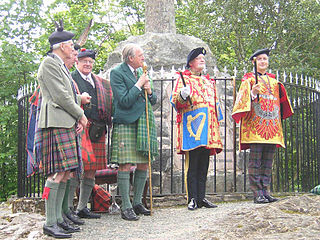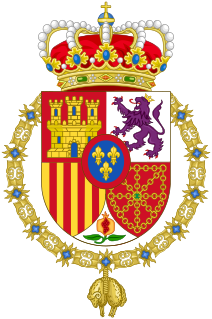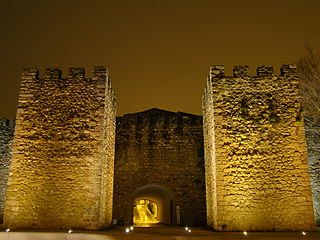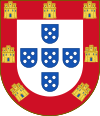 The arms of Portugal, used as the office insignia of the Portugal Rei de Armas | |
| Heraldic tradition | Portuguese |
|---|---|
| Jurisdiction | Portugal |
| Governing body | Cartório da Nobreza |

Portugal Rei de Armas or Rei de Armas Portugal (Portuguese for "Portugal King of Arms") was the title of the main officer of arms of the Kingdom of Portugal. The office was established by King John I of Portugal, with its first holder being an Englishman named Harriet.
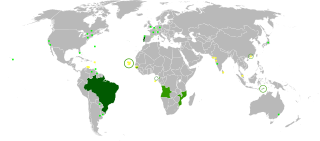
Portuguese is a Western Romance language originating in the Iberian Peninsula. It is the sole official language of Portugal, Brazil, Cape Verde, Guinea-Bissau, Mozambique, Angola, and São Tomé and Príncipe. It also has co-official language status in East Timor, Equatorial Guinea and Macau in China. As the result of expansion during colonial times, a cultural presence of Portuguese and Portuguese creole speakers are also found in Goa, Daman and Diu in India; in Batticaloa on the east coast of Sri Lanka; in the Indonesian island of Flores; in the Malacca state of Malaysia; and the ABC islands in the Caribbean where Papiamento is spoken, while Cape Verdean Creole is the most widely spoken Portuguese-based Creole. Reintegrationists maintain that Galician is not a separate language, but a dialect of Portuguese. A Portuguese-speaking person or nation is referred to as "Lusophone" (Lusófono).

An officer of arms is a person appointed by a sovereign or state with authority to perform one or more of the following functions:

The Kingdom of Portugal was a monarchy on the Iberian Peninsula and the predecessor of modern Portugal. It was in existence from 1139 until 1910. After 1415, it was also known as the Kingdom of Portugal and the Algarves, and between 1815 and 1822, it was known as the United Kingdom of Portugal, Brazil and the Algarves. The name is also often applied to the Portuguese Empire, the realm's extensive overseas colonies.
The office was restructured in the scope of the new law that reformed the Portuguese heraldry, decreed by King Manuel I in 1512. The office was abolished when the Portuguese Monarchy was replaced by the Republic in 1910.

Portuguese heraldry encompasses the modern and historic traditions of heraldry in Portugal and the Portuguese Empire. Portuguese heraldry is part of the larger Iberian tradition of heraldry, one of the major schools of heraldic tradition, and grants coats of arms to individuals, cities, Portuguese colonies, and other institutions. Heraldry has been practiced in Portugal at least since the 11th century, however it only became standardized and popularized in the 16th century, during the reign of King Manuel I of Portugal, who created the first heraldic ordinances in the country. Like in other Iberian heraldic traditions, the use of quartering and augmentations of honor is highly representative of Portuguese heraldry, but unlike in any other Iberian traditions, the use of heraldic crests is highly popular.

Manuel I, the Fortunate, King of Portugal, was the son of Ferdinand, Duke of Viseu, by his wife, the Infanta Beatrice of Portugal. His name is associated with a period of Portuguese history distinguished by significant achievements both in political affairs and in the arts. In spite of Portugal’s small size and population in comparison to the great European land powers of France, Italy and even Spain, the classical Portuguese Armada was the largest in the world at the time. During Manuel's reign Portugal was able to acquire an overseas empire of vast proportions, the first in world history to reach global dimensions. The landmark symbol of the period was the Portuguese discovery of Brazil and South America in April 1500.
Besides the principal Portugal Rei de Armas, there were two deputy kings of arms, the Rei de Armas Algarve (Algarve King of Arms) and the Rei de Armas Índia (India King of Arms). The titles of the kings of arms were taken from the three main parts of the dominions of the Crown of Portugal, that were then the Kingdom of Portugal, the Kingdom of Algarve and the Portuguese State of India. In 1807, the Rei de Armas Índia was retitled Rei de Armas América, África e Índia (America, Africa and India King of Arms), returning to the original title after the independence of Brazil, recognized by Portugal in 1825.

The Algarve is the southernmost region of continental Portugal. It has an area of 4,997 km2 (1,929 sq mi) with 451,006 permanent inhabitants, and incorporates 16 municipalities. The region has as its administrative centre in the city of Faro, where both the region's international airport (FAO) and public university, the University of Algarve, are located. Tourism and related activities are extensive and make up the bulk of the Algarve's summer economy. Production of food, which includes fish and other seafood, different types of fruit such as oranges, figs, plums, carob beans, and almonds, is also economically important in the region. Although Lisbon surpasses the Algarve in terms of tourism revenue, the Algarve is still, overall, considered to be the biggest and most important Portuguese tourist region, having received an estimated total of 7.1 million tourists in 2017. Its population triples in the peak holiday season due to seasonal residents. The Algarve is also increasingly sought after, mostly by central and northern Europeans, as a permanent place to settle. A 2016 American-based study concluded that the Algarve was the world's best place to retire.

India, also known as the Republic of India, is a country in South Asia. It is the seventh largest country by area and with more than 1.3 billion people, it is the second most populous country as well as the most populous democracy in the world. Bounded by the Indian Ocean on the south, the Arabian Sea on the southwest, and the Bay of Bengal on the southeast, it shares land borders with Pakistan to the west; China, Nepal, and Bhutan to the northeast; and Bangladesh and Myanmar to the east. In the Indian Ocean, India is in the vicinity of Sri Lanka and the Maldives, while its Andaman and Nicobar Islands share a maritime border with Thailand and Indonesia.

The State of India, also referred as the Portuguese State of India or simply Portuguese India, was a state of the Portuguese Overseas Empire, founded six years after the discovery of a sea route between Portugal and the Indian Subcontinent to serve as the governing body of a string of Portuguese fortresses and colonies overseas.
The kings of arms were assisted by three heralds (Arauto Lisboa, Arauto Silves and Arauto Goa) and by three pursuivants (Passavante Santarém, Passavante Lagos and Passavante Cochim). The titles of the heralds and pursuivants were taken from main cities and towns of Portugal (Lisbon and Santarém), the Algarve (Silves and Lagos) and the Portuguese India (Goa and Kochi). The Arauto Silves was later retitled Tavira . [1] [2]
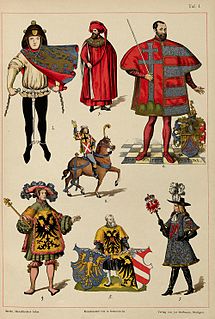
A herald, or a herald of arms, is an officer of arms, ranking between pursuivant and king of arms. The title is commonly applied more broadly to all officers of arms.

A pursuivant or, more correctly, pursuivant of arms, is a junior officer of arms. Most pursuivants are attached to official heraldic authorities, such as the College of Arms in London or the Court of the Lord Lyon in Edinburgh. In the mediaeval era, many great nobles employed their own officers of arms. Today, there still exist some private pursuivants that are not employed by a government authority. In Scotland, for example, several pursuivants of arms have been appointed by Clan Chiefs. These pursuivants of arms look after matters of heraldic and genealogical importance for clan members.

Lisbon is the capital and the largest city of Portugal, with an estimated population of 505,526 within its administrative limits in an area of 100.05 km2. Its urban area extends beyond the city's administrative limits with a population of around 2.8 million people, being the 11th-most populous urban area in the European Union. About 3 million people live in the Lisbon Metropolitan Area, including the Portuguese Riviera,. It is mainland Europe's westernmost capital city and the only one along the Atlantic coast. Lisbon lies in the western Iberian Peninsula on the Atlantic Ocean and the River Tagus. The westernmost areas of its metro area form the westernmost point of Continental Europe, which is known as Cabo da Roca, located in the Sintra Mountains.






